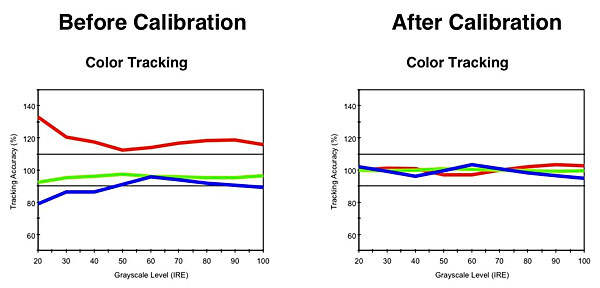NuVision Lucidium NVU55FX10LS 3D LCD HDTV HT Labs Measures
Black: 0.003
White: 33.9
Full-On/Full-Off Contrast Ratio: 11,300:1
These readings were taken in 2D with the Contrast on 62, the Brightness on 38, the Gamma on 2.0, and True Dimming engaged (the same settings were used for the remainder of the measurements, except as noted). The readings were taken at center screen; the black levels were higher at the edges of the screen due to the uneven edge-light diffusion mentioned in the review.

With True Dimming off, the peak white level increased to 37.7 foot-lamberts and the black level to 0.018 ft-L, resulting in a full-on/full-off contrast ratio of 2,094:1.
The NuVision would not go above white (a video level of 235) or below black (a video level of 16) in some situations. It would only do so when the input was RGB video, not Y/Cb/Cr. In addition, this RGB must be RGB Video. Some sources offer both RGB Video and RGB Enhanced options, but only the RGB Video will pass above white and (usually) below black in the Blu-ray players we tried from Panasonic, LG, Samsung, Pioneer, OPPO, and Marantz. The passing grade shown in the Video Test Bench chart assumes the use of a compatible RGB input. Most players offer such an option in their setup menu, but a few do not, such as the Samsung BD-C6900. Also, an LG BX580 passed above white in RGB on the NuVision, but not below black.
The Before Calibration color balance in the Warm Color Temperature setting was poor. But a full calibration improved matters significantly. All of the final Delta E values from 20 IRE to 100 IRE were under 3.0, apart from 60 IRE (3.8), 90 IRE (4.1), and 100 IRE (4.96).
There is no 2D-to-3D conversion mode, so we did not perform a separate 3D calibration. But the color balance in 3D didn’t appear to be visibly compromised relative its 2D performance.

The set’s color gamut, shown in the CIE chart, is slightly oversaturated in green (a common deviation) and blue (less common) and undersaturated in red (uncommon). The green and blue deviations were never obtrusive. While I did see some instances in which red looked less vivid than it should, it never bothered me. There is no color management system available to tweak the set’s color gamut, nor any menu options for selecting a different, fixed gamut.
Even in the lowest 2.0 Gamma setting, the gamma averaged about 2.6 from 20 IRE to 50 IRE. It increased to just under 2.9 at 60 IRE and just over 2.7 at 70 IRE before decreasing to 2.32 at 90 IRE. The ideal gamma ranges from 2.2 to 2.4. The higher numbers measured here indicate that an image from near black to near peak white is darker than optimum.—TJN














































